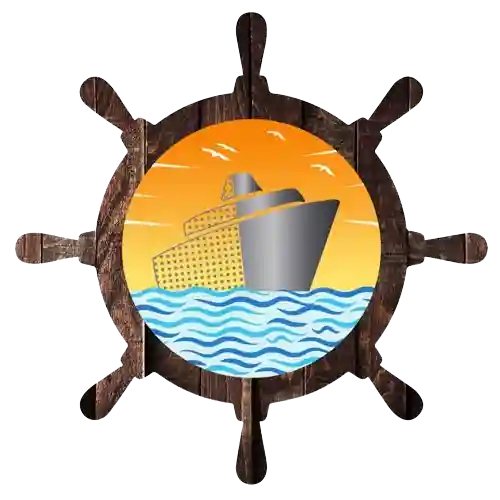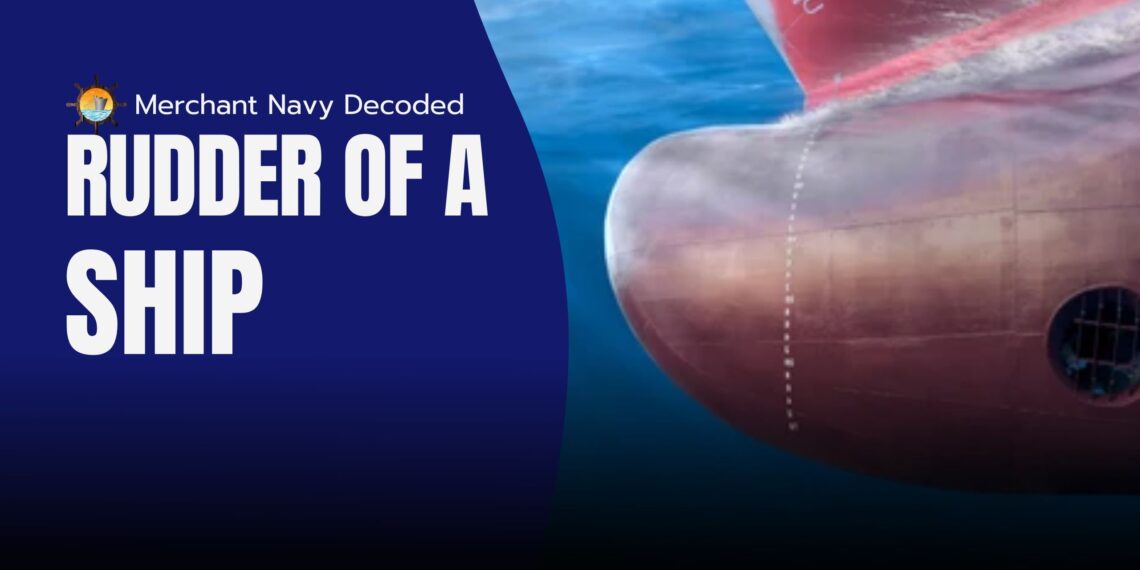Rudder on Ship & Types of Rudder of Ship
1: What is Rudder?
A rudder is a basic controller to steer ships, boats, submarines, hovercraft, airships, and other vehicles.
Rudders move through fluid mediums, such as air or water. On airplanes, the rudder is primarily used to counteract adverse yaw and p-factor rather than make direct turns.
The rudder is used to steer the ship. The turning action is largely dependent on the rudder’s area. The required area of the rudder varies with different types of vessels since the desired maneuvering ability differs considerably, and the general ship design may impose restrictions.
2: What is Rudder in Ship?
A rudder is a mandatory part of a ship’s steering mechanism. It is mainly made of metal, wood, or plastic, it is located at the stem or rear of the vessel.
The rudder controls the ship’s direction by adjusting its angle concerning the water flow. Similar to how a steering wheel guides a car, the rudder determines the course of a ship, making it important for safe and efficient navigation on the seas.
3: What is the Importance of a Rudder on Ship?
Without a rudder, a ship would lack precise control over its direction, making navigation unsafe and inefficient.
It is an indispensable tool for steering and it ensures the vessel responds effectively to commands and environmental conditions like wind and currents.
It also plays an important role in maneuverability:
- Course Adjustment: The rudder makes minor course corrections during straight-line travel.
- Turning the Ship: It helps the ship make sharp or gradual turns, necessary while navigating in narrow channels or busy ports.
- Any Emergency Situation: The rudder can help in rapid directional changes to avoid collisions.
4: Types of Rudders used on Ships
1. Balanced Rudder
A balanced rudder is also known as a spade rudder. It is essentially a rudder plate attached to the rudder stock solely at its upper end.
In other words, the rudder stock, or the axis around which the rudder pivots, does not extend down the full length of the rudder.
The placement of the rudder stock along the rudder’s chord determines whether the rudder is classified as balanced or semi-balanced.
2. Unbalanced Rudders
In these types of rudders, the stocks are connected at the forwardmost point of their span.
Unlike balanced rudders, the rudder stock extends along the chord length of the rudder. This design is because the torque required to turn the rudder is significantly higher than that of a corresponding balanced rudder. To prevent the rudder from shifting vertically from its natural position, the topmost part of the rudder must be securely fixed to the spindle.
3. Semi Balanced Rudder
When the steering gear system failed, people faced problems with both balanced and unbalanced rudders, so a semi-balanced rudder was developed to avoid this issue.
A semi-balanced rudder has a chord length completely balanced but the upper portion of the chord length is unbalanced.
The balanced half allows a very small amount of torque to move the rudder and the unbalanced part extends the proper structural support.
4. Flap Rudder
A flap rudder is an advanced type of ship rudder that features a hinged flap on the trailing edge of the main rudder blade.
This flap moves in coordination with the main rudder and improves the vessel’s steering performance.
They are especially effective for slow-speed maneuvers, such as navigating through narrow channels.
5. Twin Rudders
Twin rudders are a configuration where two rudders are placed side by side, typically behind each propeller in a dual-propeller system.
They are an advanced rudder design used in specific vessel types to improve maneuverability, control, and efficiency, especially in challenging conditions.
What is a Rudder Carrier?
The rudder is the common name for the bearing device fixed to the hull to support the rudder.
A rudder carrier is mainly used to support the weight of the rudder rod and rudder and to ensure that the hull is watertight.
It acts as a bearing structure, reducing the stress on other parts of the steering gear and ensuring the smooth operation of the rudder.
Components of a Rudder Carrier:
- Bearing Surface: It is made of materials like bronze, composite, or some other wear-resistant material that can reduce friction and also handle heavy loads.
- Housing: This robust structure holds the bearing and connects it to the rudder system and the ship’s hull.
- Grease or Lubrication System: This ensures smooth movement and minimizes wear over time.
- Seals: They prevent water ingress and protect internal components from corrosion or wear.
How Does the Rudder Help in Turning Ships?
The rudder plays an important role in steering a ship by redirecting the water flow past the stern.
- The rudder is mainly mounted at the stern of the ship, just behind the propeller.
- When the steering wheel is turned, it rotates the rudder via mechanical, hydraulic, or electrical systems.
- The rudder’s basic function is to deflect water flow. When the rudder is turned to one side, it changes the direction of the water pushed by the propeller.
- This creates an imbalance in water pressure: higher pressure on one side of the rudder and lower pressure on the other.
- This pressure difference generates a force, called the lateral force, which acts perpendicular to the rudder surface.
- This force creates a torque that turns the stern of the ship in the opposite direction.
- As the stern moves, the ship pivots around its center of gravity.
FAQs
Q. How many rudders does a ship have?
Ans: A ship mainly has one large rudder.
Q What is the keel used for?
Ans: Keel is used to hold the ballast that keeps the boat right-side up.
Q. What is a rudder in nautical terms?
Ans: A rudder is an underwater blade, positioned at the stem of the ship controlled by the steering gear.
Disclaimer :- The opinions expressed in this article belong solely to the author and may not necessarily reflect those of Merchant Navy Decoded. We cannot guarantee the accuracy of the information provided and disclaim any responsibility for it. Data and visuals used are sourced from publicly available information and may not be authenticated by any regulatory body. Reviews and comments appearing on our blogs represent the opinions of individuals and do not necessarily reflect the views of Merchant Navy Decoded. We are not responsible for any loss or damage resulting from reliance on these reviews or comments.
Reproduction, copying, sharing, or use of the article or images in any form is strictly prohibited without prior permission from both the author and Merchant Navy Decoded.




